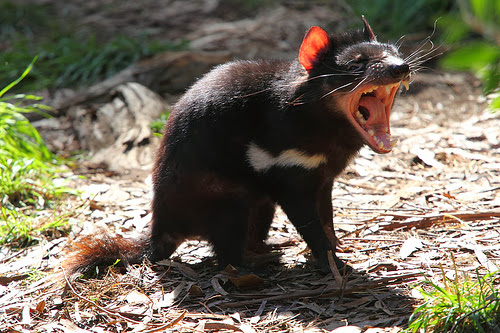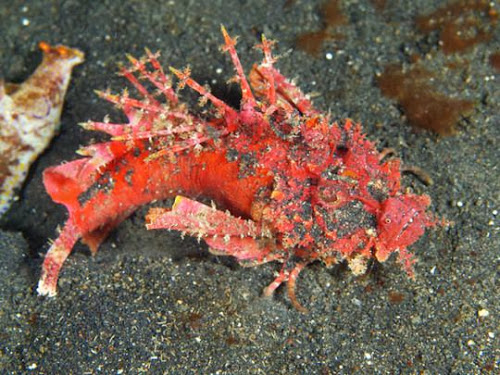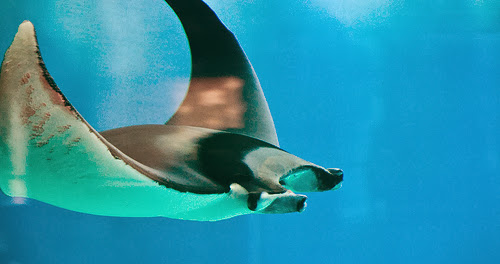What’s in a name? Glancing at the article title, ‘10 Intriguing Devil Animals’, probably your initial reaction would be — that the list presents terrifying, frightening or cruel animals. You might be right or totally wrong. One thing is sure — after digesting all the information you will definitely agree with the author that the old adage “Don’t always judge a book by its cover” or “don’t judge a species by its name” is indeed TRUE! Read and learn.
Thorny Devil
The Thorny Devil (Moloch horridus),also known as thorny dragon, the Moloch, the thorny lizard, or the mountain devil, is an amazing Australian reptile. It got its name owing to the two large horned scales resembling that of a devil. Despite its appearance, this intriguing creature is totally harmless!
Range and Habitat: The only species in its genus (Moloch), the species are found in central and western Australia inhabits deserts and arid scrubland. An endangered animal, the slow moving lizard can live for about 20 years.
Description: The whole upper side of the lizard’s body is covered with thorns (conical spines.) Also, the creature features a spiny “false head” on the back of its neck These natural spikes acts as a defense mechanism against predators. The thorny devil can measure up to 20 cm (8.0 inches) long (including the tail) Females are bigger than males. In general, the species are brown and tan in color. Did you know? This reptile has the ability to change color.
Diet: Thorny devils feed mainly on ants — using their tongue. It can consume about 600 to 3000 ants in a single meal!
Tasmanian Devil
The Tasmanian Devil (Sarcophilus harrisi) is the largest surviving carnivorous marsupial. Early European settlers on the island of Australia were the first to call this fierce-looking animal the Devil. The reason — its black color, its spine-chilling screeches and reputed bad temper. Tasmanian devils are listed as ‘Endangered’ and are wholly protected.
Range and habitat: The species were once widespread over Australia, but today’s population is now contained in the forests and open woodlands of Tasmania.
Description: Resembling a medium-sized dog, the Tasmanian Devil is robustly built and owns a powerful, bone-crunching jaws. Generally, it has black, coarse fur marked with white patches running across the chest, shoulders and rear end It has a large head, long whiskers, and a hairy tail about 25 cm (10 inches) long. It has long front legs and shorter rear legs. On average, adults measure 20 to 31 in (51 to 79 cm) in length and weigh 4 to 12 kg (9 to 26 pounds).
Diet: Generally, this intriguing animal eats just about anything – from carrion (dead meat), to killing small animals like birds, crayfish, frogs, lizards, kangaroos, snakes, and wallabies. Do you know that Tasmanian devils produce a pungent odor when threatened or under stress.
Devil Crab
The Velvet Crab (Necora puber), also known as Devil Crab, velvet swimming crab, is a fast-moving and largest swimming crab common in British coastal waters. The species got its alternative name owing to its bright-red eyes and aggressive behavior.
Range and habitat: The species has a wide distribution in north-west Europe. This velvety-colored crabs prefer on fairly sheltered shores and rocky bottoms up to about 65 m (213 ft).
Description: A fairly-size crab with a flattened carapace measuring up to 100 mm (3.9 in) wide. It has bright-red eyes, the top side of the carapace has a reddish-brown velvety covering, and also velvety pincers. Between the eyes, ten narrow teeth sit on the edge of the carapace.
Diet: Juveniles feed mainly on crustaceans while adult diet includes mollusks, brown seaweeds as well as crustaceans
Giant Devil’s Flower Mantis
The Giant devil’s Flower Mantis (Idolomantis diabolica),is one intriguing species of praying mantis that mimics flowers. It is also the largest and one of the scariest species of praying mantis.
Range and habitat: The species is native to Ethiopia, Kenya, Tanzania, and Uganda.
Description: Females measure to about 13 cm (5 in) while males can reach 10 cm (4 in) in length. Its appendages, wings and other body parts often resemble petals or foliage. Generally, the species adapt the host flora’s color that includes: blue, black, purple, red and white.
Spiny Devilfish
The Spiny Devilfish (Inimicus didactylus), also called as Demon Rockfish, Devil Stinger or the Bearded Ghoul, is a species of stonefish known for its poisonous dorsal fin spines that inflict excruciating pain if trodden upon.
Range and habitat: The species is widespread all over the Indo-Pacific region including Thailand, the Philippines and Maldives. Generally, Spiny Devilfish prefers lagoons, seaward reefs buried in sand or silt.
Description: The fish remarkable features are his front fins, that resembles fingers. It has an elongated body, large pectoral fins and sharply-curved tails. Color ranges from chocolate brown to red and even bright orange. It has modified pectoral rays that it uses to walk with. Adults can grow to about 25 cm long.
Diet: Spiny Devilfish are known solitary species and feed mostly on fish and invertebrates.
Sand Devil
The Sand Devil (Squatina dumeril) or Atlantic Angel Shark is a sleepy, bottom-grubbing shark that can be ferociously aggressive if stepped on or captured — thus gets the moniker “sand devil”.
Range and habitat: The species has a wide geographical distribution that covers the waters of Western North Atlantic regions. It is found from the surface to depths of 4,560 feet 1,390 m (4,560 feet).
Description: Adult ones can reach up to 1.5 m (5 ft) long. It has an overall flattened body with eyes situated on top of the head, laterally expanded pectoral fins, two spineless dorsal fins, no anal fin and five pairs of gill slits.
Diet: Sand Devils diet includes crustaceans, bivalves, cephalopods, gastropods, and small bony fishes.
Hickory Horned Devil
The Hickory Horned Devil, is the intriguing caterpillar of the Regal Moth (Citheronia regalis). This scary-looking caterpillar is known for its horn, thus getting its name.
Description: This gentle giant is metallic green in color, orange head with long spiky horns tipped with black. The back and sides of the body sport strings of short black spines. The horns, while frightening, don’t even sting. Just like most caterpillars, the Hickory Horned Devil develops through four larval stages, and grow to a remarkable length (up to 6 inches).
Diet: During summer, these caterpillars feed on leaves of trees such as hickory, persimmon, sweet gum, or walnut. When fully grown, larvae burrow into the soil and pupate.
Devil’s Coach Horse
The Devil’s Coach Horse (Ocypus olens) is the largest of around 1000 species of rove beetles. This species got its name from Irish mythology where this creature symbolizes a form of corruption. As far back as the Middle Ages, it was believed to have the power to kill on sight or curse a person by raising its tail. The species may sound like an evil insect, but the Devil’s Coach Horse plays a major role in the food chain as a beneficial predator.
Range and habitat: The species are widespread across Europe and a common beetle in the UK. These critters prefer a variety of habitats such as gardens, meadows and woodlands.
Description: This little black devil has an elongated body, pincer-like jaws, shortened wing cases (elytra), and exposed powerful abdomen. Adults measures to about 25–28 millimeters (1.0–1.1 in).
Diet: Devil’s Coach Horses are carnivorous predators. Its diet includes carrion, spiders, slugs, woodlice, worms, and other invertebrates.
Devil Rider
The Southern Two-Striped Walkingstick (Anisomorpha buprestoides), also known as the Devil Rider or Musk Mare is a species of stick insect famous for its very deadly chemical defense spray. This insect emits a milky substance from a pair of glands, that can cause extreme irritation or temporarily blind people if introduced into the human eye.
Range and habitat: Devil riders are widespread throughout the southeastern United States.
Description: Devil’s rider walkingstick comes in three color forms: a “brown form”, a “white form”, and an “orange form”. Females average 67.7 mm long, while males average in 41.7 mm. Most species have a body with leaf-like lateral extensions.
Diet: This intriguing devil animal is herbivorous, feeding mostly on the leaves of trees and shrubs.
Giant Devil Ray
The Giant Devil Ray or devil fish (Mobula mobular) is an endangered type of ray known for its hornlike cephalic fins, giving this fish its name. These gentle giants move around in groups while making long migrations
Range and habitat: These devil rays are most common throughout the Atlantic Ocean, inhabiting offshore, deep waters. At times can also be found in shallow waters.
Description: The species is recognizable by its flat, diamond shape body. a large, pointed pectoral fins, a mouth containing few teeth, and spiny tail. The upper side is dark while its underside is mostly white. It can reach up to 5.2 m (17 ft) in length, up to 520 cm in disk width, and can weigh up to 1300 kg.
Diet: Devil rays feed on plankton, crustaceans and small pelagic fishes.










I learn something new everytime I visit your blog.. These animals are not toxic too..
I was lucky enough to see a tazmanian devil and I find them cute because of their mischief.
wow! first time I heard and saw these animals! I love the Thorny Devil, looks so cool and dangerous.
This is another great list of animals I have never heard of yet! Your posts are always very informative.
the Tasmanian devil is a cutey for me and a fav character … why they have to be tagged as devil in the first place?
These animals are all amazing! The world is really a wonderful place for every species to thrive in.
i have seen tasmanian devil when I was in australia it was like a rat haha but really scary sounds it makes
Wow, I never knew these existed until I saw this post – very educational and amazing for me. 🙂
I prefer not to use the "D" word. Weird or Odd looking can be some of the options. = ) Thanks for posting though. I love seeing new animals in different forms.
Don't get me wrong, I love all of God's creation but I don't know, i find all of them a little creepy.
The Thorny Devil looks scary! I wouldn't dare go near it 😀
Lol, wow., why in the world are these animals named devil!
I KNEW ABOUT THE FIRST TWO ANIMALS BUT I DIDN’T KNOW ABOUT THE REST UNTIL I VISIT YOUR BLOG.THANKS FOR THE INFORMATION.